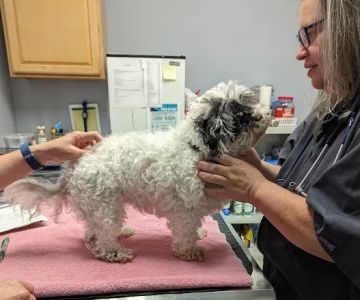Identifying and Treating Dehydration in Pets
As a pet owner, one of my most important responsibilities is to ensure my pet stays hydrated, especially during the hot summer months or after intense exercise. I learned this lesson the hard way when my dog, Max, developed dehydration after a long day at the park. He became lethargic, and I noticed his skin wasn’t bouncing back after I gently pinched it. That’s when I realized something was wrong, and I had to act quickly. Dehydration in pets can be dangerous, but fortunately, identifying it early and taking the right steps can help prevent serious health issues.

11841 Mason Montgomery Rd, Cincinnati, OH 45249, USA
See DetailsUnderstanding Dehydration in Pets
Dehydration occurs when a pet loses more fluids than it takes in, leading to an imbalance of water and electrolytes in their body. It can happen quickly, especially during hot weather or intense physical activity, and pets are just as prone to dehydration as humans. In fact, pets such as dogs and cats may not always show obvious signs until the dehydration becomes severe. That’s why I believe it’s essential for pet owners to stay vigilant and know the signs of dehydration so they can intervene before the situation becomes critical.
Common Causes of Dehydration in Pets
There are several reasons why pets may become dehydrated. Understanding these causes can help you prevent dehydration before it becomes a problem.
1. Hot Weather and Heatstroke
Max, like many pets, loves playing outside, but when temperatures soar, he becomes more susceptible to dehydration. Heatstroke can quickly lead to dehydration if pets aren’t provided with plenty of water and shade. Pets with thick fur coats, such as Max, are particularly at risk during the warmer months. I’ve made it a point to ensure he has constant access to fresh water when we go outdoors and avoid too much activity during peak heat hours.
2. Illness or Infection
Dehydration can also occur when pets are suffering from an illness, such as gastrointestinal issues, fever, or infections. For example, when Max had a stomach bug, he experienced vomiting and diarrhea, both of which contributed to his dehydration. Pets with respiratory infections may also become dehydrated due to fever or loss of appetite, which makes it harder for them to drink. In these cases, it’s critical to ensure your pet stays hydrated and see a vet for treatment.
3. Reduced Water Intake
Sometimes, pets may not drink enough water due to a variety of reasons. Stress, a change in routine, or the introduction of a new pet or person into the household can cause anxiety, leading to decreased water consumption. Max, for instance, can become quite stressed when we go on trips, and his water intake drops as a result. To encourage him to drink more, I use different bowls, sometimes even adding ice cubes or ice chips to make the water more enticing.
4. Excessive Physical Activity
If your pet exercises intensely without adequate hydration, they’re at risk of dehydration. This is something I keep in mind when we go for long runs or hikes. Max is an active dog, and I make sure he drinks water frequently during our outings. Lack of hydration during strenuous activity can cause dehydration and, in extreme cases, heatstroke, which can be life-threatening if not addressed quickly.
Signs of Dehydration in Pets
Dehydration doesn’t always present itself clearly, especially in its early stages. However, there are some telltale signs to watch out for. Here are the common signs of dehydration in pets that I look for:
1. Lethargy or Weakness
One of the first signs I noticed when Max was dehydrated was a sudden drop in his energy levels. He was unusually tired and seemed unwilling to engage in his usual activities. Lethargy can indicate that your pet is dehydrated and unable to keep up with normal energy demands. If your pet seems unusually tired or weak, it’s time to assess their hydration levels.
2. Dry Gums and Mouth
Another quick way to check for dehydration is to examine your pet’s gums and mouth. Healthy gums should be moist and pink. If they feel dry or sticky to the touch, or if the gums appear pale, your pet may be dehydrated. I always check Max’s gums when I suspect dehydration, and if they feel dry, it’s a clear indicator that I need to get him hydrated immediately.
3. Sunken Eyes
Sunken eyes are a common sign of moderate to severe dehydration. The eyes appear dull and might look like they are set deeper into the sockets. This symptom is more apparent in cats but can also occur in dogs. If I notice Max’s eyes looking dull or his face appearing “saggy,” I take it as a serious warning sign.
4. Loss of Skin Elasticity
A simple test I use to check for dehydration is the skin tent test. To do this, I gently pinch the skin at the back of Max’s neck or between his shoulder blades and then release it. In a well-hydrated pet, the skin should quickly snap back into place. If the skin stays pinched for a few seconds before returning to its normal position, it’s an indication that Max may be dehydrated.
5. Increased Heart Rate and Panting
Dehydration can cause an increase in heart rate and excessive panting. Max becomes more panty and his breathing feels labored when he’s dehydrated. If your pet is panting heavily despite being at rest, or their heart rate seems elevated, these are signs that they need hydration immediately.
How to Treat Dehydration in Pets
The treatment for dehydration depends on the severity of the condition. In mild cases, you can often treat your pet at home by encouraging them to drink water and offering electrolyte solutions. However, in more severe cases, veterinary intervention may be required. Here are the treatment steps I follow to help Max recover from dehydration:
1. Offer Fresh Water
The first step in treating mild dehydration is to encourage your pet to drink water. Always offer fresh, clean water, and I find that some pets prefer water with added flavor or coolness. For Max, I sometimes add ice cubes to his water or use a pet water fountain to keep him more interested. If your pet isn’t drinking, try using a syringe (without a needle) to gently squirt water into their mouth, or offer ice cubes to lick.
2. Use Oral Electrolyte Solutions
If your pet is suffering from moderate dehydration, I often use electrolyte solutions designed for pets. These solutions help replace the lost minerals and fluids that are necessary for normal body function. Max actually prefers flavored electrolyte solutions, which makes it easier to get him to drink more. Always check with your vet before introducing any new product.
3. Veterinary Intervention for Severe Dehydration
If your pet is severely dehydrated, you should take them to the vet immediately. Severe dehydration can be life-threatening, and it often requires intravenous (IV) fluids to rehydrate the body quickly. I remember when Max had a more serious case of dehydration, and the vet administered IV fluids to restore his hydration levels. In these cases, the vet may also run tests to check for underlying causes of dehydration, such as infections or organ issues.
4. Prevention Is Key
The best way to treat dehydration is to prevent it from happening in the first place. I make sure Max has constant access to fresh water, especially during the summer months or after physical activity. I also keep him cool and shaded during hot weather, and limit his exposure to intense heat. Prevention is essential to keeping your pet happy and healthy.










